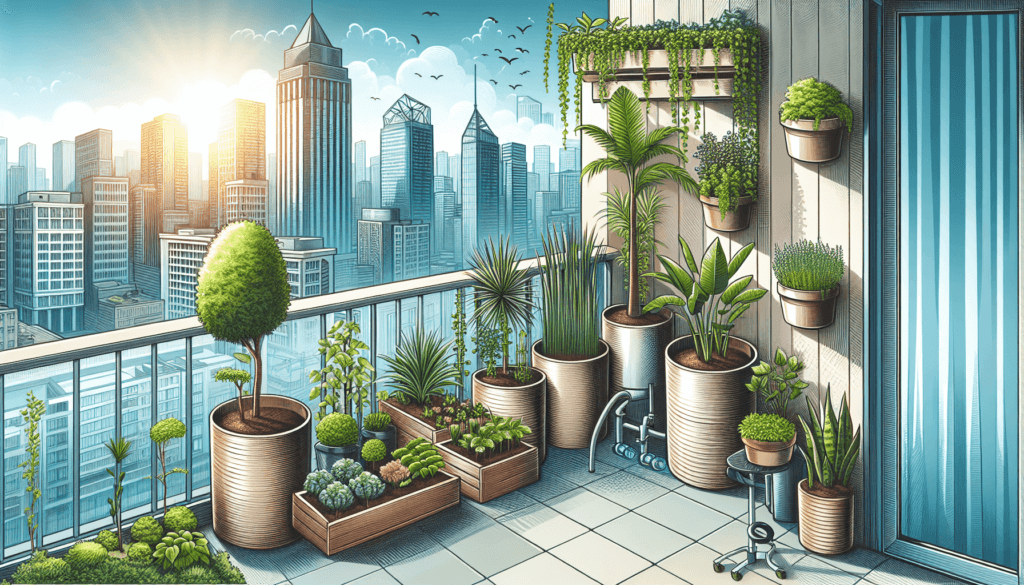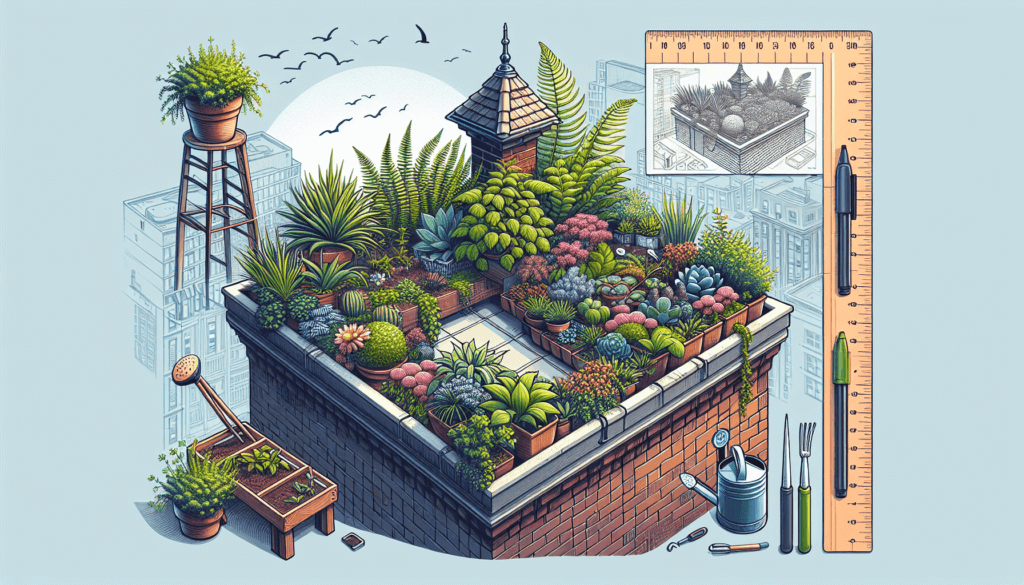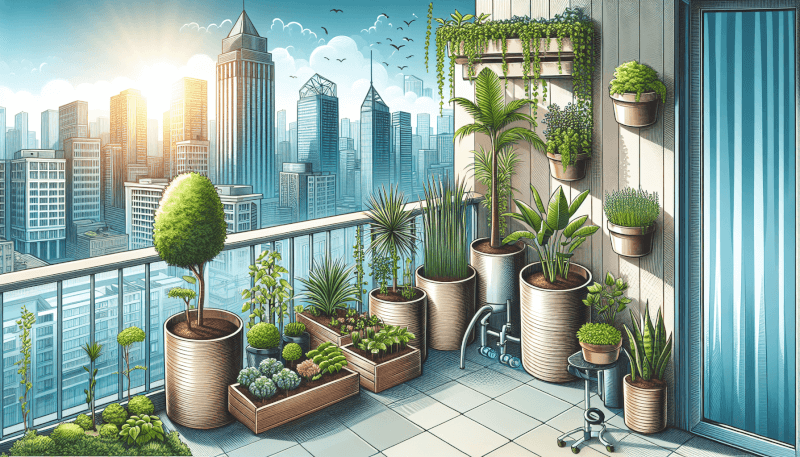Are you ready to transform your urban space into a vibrant oasis of greenery? Look no further than our guide on choosing the right plants for your urban garden. With the hustle and bustle of city living, finding the perfect plants that thrive in limited space and urban environments can seem daunting. However, armed with the right knowledge, you can create a thriving green haven right at your doorstep. Whether you have a balcony, rooftop, or a few sunny windowsills, we will help you select the ideal plants that will not only survive but flourish in your urban garden. Let’s dive in and discover the wide variety of plants that are well-suited for urban gardening!

Climate and Environment
Understanding your climate
When choosing plants for your urban garden, it’s essential to understand the climate in your area. Different plants have different temperature and humidity requirements, so knowing your climate will help you select plants that will thrive in your garden.
Assessing the available space
Before you start planting, take some time to assess the available space in your urban garden. Consider the size and shape of your garden beds, as well as any containers or vertical structures you plan to use. This will help you determine how many plants you can fit into your space.
Considering sunlight exposure
Sunlight is crucial for plant growth, so it’s important to consider the amount of sunlight your urban garden receives. Observe your garden throughout the day and note which areas receive full sun, partial sun, or shade. This information will guide you in selecting plants that match the sunlight exposure in your garden.
Evaluating soil conditions
The quality of your soil plays a significant role in plant growth. Assess the soil in your urban garden to determine its composition and fertility. You may need to amend the soil with additional nutrients or organic matter to improve its quality. Understanding your soil conditions will help you select plants that are well-suited to your specific soil type.
Types of Plants
Annuals vs Perennials
Annual plants complete their entire lifecycle in one growing season, while perennials continue to thrive year after year. Consider whether you prefer the excitement of planting new annuals every year or the longevity of perennials. Depending on your preference, you can select a mix of both types to add variety to your urban garden.
Fruit and vegetable plants
Growing your own fruits and vegetables in an urban garden is not only rewarding but also a great way to have fresh and organic produce right at your doorstep. Consider the available space and select fruit and vegetable plants that are well-suited to your climate and gardening conditions.
Herbs and spices
Herbs and spices are wonderful additions to any urban garden. They not only add flavor to your meals but also offer fragrant foliage and beautiful flowers. Consider growing herbs like basil, mint, and rosemary, as well as spices like thyme and oregano, to enhance your culinary experience.
Flowering plants
Adding flowering plants to your urban garden can bring a burst of color and beauty to your outdoor space. Whether you prefer vibrant annual flowers or perennial blooms, there are countless options to choose from. Consider the color palette, bloom time, and plant size when selecting flowering plants for your garden.
Space and Size
Vertical gardening
If you have limited space in your urban garden, vertical gardening is a fantastic option. By utilizing walls, fences, or trellises, you can grow plants vertically, saving precious space. Vining vegetables like tomatoes and cucumbers, as well as climbing flowers like morning glories and clematis, are perfect choices for vertical gardening.
Container gardening
Container gardening is ideal for urban gardeners with limited ground space. You can use containers of various sizes and shapes to grow a wide range of plants, from herbs and vegetables to flowers and shrubs. Make sure to choose containers with adequate drainage and select plants that are suitable for container gardening.
Balcony and rooftop gardens
If you live in an apartment or have a flat rooftop, you can still create a stunning garden. Balcony and rooftop gardens offer unique gardening opportunities, allowing you to take advantage of the available space. Select plants that are well-suited to your climate, consider weight restrictions, and ensure proper drainage to create a thriving balcony or rooftop garden.
Community garden plots
If you don’t have adequate space for gardening at home, consider joining a community garden. Community gardens provide shared plots where you can grow your own plants and enjoy the benefits of a supportive gardening community. Check with local organizations or municipalities to find community garden plots in your area.
Maintenance Level
High maintenance plants
Some plants require more care and attention than others. If you enjoy spending time in your garden and have the time and dedication to devote to plant care, high maintenance plants may be suitable for you. These plants may require regular pruning, fertilizing, and pest control to keep them healthy.
Low maintenance plants
If you have a busy lifestyle or prefer a more hands-off approach to gardening, consider selecting low maintenance plants for your urban garden. These plants are often hardy and can tolerate a range of growing conditions with minimal care. Succulents, ornamental grasses, and certain shrubs are excellent choices for low maintenance gardening.
Drought-tolerant plants
Water conservation is an essential consideration in urban gardening. Choosing drought-tolerant plants can help minimize water usage while still creating a beautiful garden. Look for plants that have adapted to arid climates and can thrive with minimal watering once established.
Pest and disease resistance
Dealing with pests and diseases can be a challenge in any garden. To minimize the risk of plant damage, choose plants that are known for their pest and disease resistance. Research different plant varieties and select those that are known to be less susceptible to common garden pests and diseases prevalent in your area.

Edible Plants
Choosing suitable vegetables
When selecting vegetables for your urban garden, consider your personal preferences and the available space. Some vegetables, such as lettuce and radishes, are well-suited for small spaces or containers, while others, like squash and corn, require more room to grow. Choose vegetables that you enjoy eating and that can thrive in your specific urban gardening conditions.
Selecting fruit-bearing plants
Growing your own fruits in an urban garden can be incredibly rewarding. From strawberries and blueberries to apples and peaches, there are many fruit-bearing plants suitable for small spaces. Consider the size and pollination requirements of fruit trees, vines, and bushes when making your selections.
Growing herbs and spices
Fresh herbs and spices can elevate your cooking and bring a delightful aroma to your urban garden. Consider growing herbs like parsley, chives, and cilantro, as well as spices like cumin and turmeric. These plants are often compact and can thrive in containers or small garden spaces.
Ensuring food safety
When growing edible plants in your urban garden, it’s essential to prioritize food safety. Use organic growing methods whenever possible, and avoid using harmful pesticides or herbicides. Wash your harvested produce thoroughly, and follow proper food storage and handling practices to ensure the safety of the food you grow.
Attracting Pollinators
Selecting pollinator-friendly plants
Pollinators play a vital role in the ecosystem and are crucial for plant reproduction. To attract pollinators like bees, butterflies, and hummingbirds to your urban garden, select plants that are known to be pollinator-friendly. Native wildflowers, herbs like lavender and sage, and flowering shrubs like butterfly bush are excellent choices.
Creating a welcoming environment
In addition to selecting pollinator-friendly plants, create a welcoming environment for pollinators in your urban garden. Provide diverse plantings with blooms throughout the growing season to ensure a continuous food source for pollinators. Avoid using pesticides that harm pollinators and provide water sources like birdbaths or shallow dishes for them to drink from.
Providing water and shelter
Pollinators need more than just nectar-rich plants. They also require water and shelter. Provide shallow dishes of water or create small ponds to help quench their thirst. Incorporate features like birdhouses, bee hotels, or brush piles to offer pollinators nesting and sheltering opportunities.
Avoiding harmful pesticides
While pests can be a nuisance in the garden, it’s important to avoid using harmful pesticides that can harm beneficial pollinators. Instead, explore organic and natural pest control methods, such as companion planting, biological controls, or homemade remedies. By avoiding harmful pesticides, you can create a safe and healthy environment for both your plants and pollinators.

Indoor and Small-Space Gardening
Choosing suitable houseplants
Indoor gardening is a great option for those who have limited outdoor space or live in apartments. When selecting houseplants for your urban garden, consider factors like light availability, humidity levels, and your personal preferences for plant care. Choose plants that are well-suited for indoor conditions and enhance the beauty of your living space.
Utilizing vertical space
In small-space gardening, maximizing vertical space is key. Utilize hanging planters, wall-mounted containers, or vertical shelving to create a lush garden in even the smallest of spaces. Vining plants like pothos and ivy are ideal for vertical gardening as they can cascade downward and add visual interest.
Container options for small spaces
Container gardening is a popular choice for small-space gardening. When selecting containers, consider the size and material. Opt for containers with adequate drainage holes to prevent waterlogging and choose materials like terracotta or plastic that can withstand outdoor conditions. Ensure that the containers are appropriately sized for the plants you intend to grow.
Hydroponics and aeroponics
For those looking for innovative and space-saving gardening techniques, hydroponics and aeroponics offer exciting possibilities. These soil-less gardening methods utilize water or mist to deliver nutrients directly to plants’ roots. With proper equipment and knowledge, you can grow a variety of plants, including leafy greens, herbs, and even small fruits, indoors or in small spaces.
Aesthetics and Design
Matching plants to urban environment
When designing your urban garden, consider the overall aesthetic and how it fits with the surrounding urban environment. Choose plants that complement the architectural style and color scheme of your surroundings. Incorporate plants that add visual interest and create a sense of harmony between nature and the built environment.
Creating visual interest
A visually appealing garden goes beyond just selecting beautiful plants. Create visual interest by incorporating elements like contrasting foliage shapes and colors, varying plant heights, and textures. Consider adding features like ornamental grasses, trailing vines, or focal point plants to add depth and dimension to your urban garden.
Color and texture combinations
Color and texture combinations can make a significant impact on the overall look and feel of your urban garden. Explore different color palettes, such as vibrant tones for a lively garden or pastel shades for a more serene ambiance. Mix plants with different textures, such as velvety leaves, spiky succulents, or feathery foliage, to create an engaging visual experience.
Using plants as focal points
Incorporating plants as focal points in your urban garden can create a stunning visual impact. Select plants with unique shapes, bold colors, or impressive sizes to draw attention. Place these focal point plants strategically to create focal areas or centerpieces within your garden design.

Native Plants
Researching local native species
Native plants are essential for maintaining biodiversity and supporting the local ecosystem. Research local native species in your area and incorporate them into your urban garden. These plants are well-adapted to the local conditions, require less water and maintenance, and provide food and habitat for native wildlife.
Promoting biodiversity
Urban gardens have the power to promote biodiversity by creating small pockets of habitat within the concrete jungle. By incorporating a variety of native plants and creating diverse planting areas, you can attract a wide range of birds, butterflies, and beneficial insects to your garden. Preserve and enhance the biodiversity of your urban environment by prioritizing native plant species.
Supporting the local ecosystem
Urban gardens can play a crucial role in supporting the local ecosystem by providing food and shelter for local wildlife. Choose plants that provide nectar, pollen, or seeds for birds, butterflies, and bees. Include plants of different heights and structures to provide nesting places and cover for small animals.
Adapting to local conditions
Native plants have adapted to the specific climate and soil conditions of your area, making them more likely to thrive in your urban garden. These plants are generally hardy and require less water, fertilizer, and maintenance compared to non-native species. By selecting plants that are naturally suited to your local conditions, you can create a resilient and sustainable garden.
Seasonal Considerations
Choosing plants for each season
To maintain year-round interest in your urban garden, choose plants that offer different seasonal features. Select flowers, foliage colors, and textures that bloom or change throughout the seasons. By planning for a variety of plants, you can enjoy a vibrant garden throughout the year.
Utilizing annuals and perennials
A mix of both annuals and perennials ensures that your urban garden remains attractive throughout the seasons. Annuals provide bursts of color and continuous blooms, while perennials offer long-lasting foliage and blooms year after year. Combine the two to create a dynamic and ever-changing garden.
Preparing for winter
Winter can present unique challenges for urban gardeners, but with proper planning, your garden can still thrive during the cold months. Choose winter-hardy plants that can withstand freezing temperatures and consider using protective measures, such as mulching or covering, to shield sensitive plants. Additionally, embrace the beauty of evergreen plants to add interest to your garden during the winter season.
Planning for year-round interest
To ensure year-round interest in your urban garden, consider incorporating elements like ornamental grasses, winter-blooming plants, and plants with interesting bark or foliage. Plant evergreens to provide structure and color during the winter months. By planning for continuous interest, you can enjoy your urban garden throughout the year.
Remember, your urban garden is a reflection of your personal style and preferences. Take the time to research and choose plants that not only thrive in your climate and garden conditions but also bring joy and beauty to your outdoor space. With careful planning and consideration, your urban garden can become a lush oasis in the heart of the city. Happy gardening!


